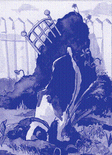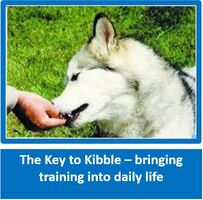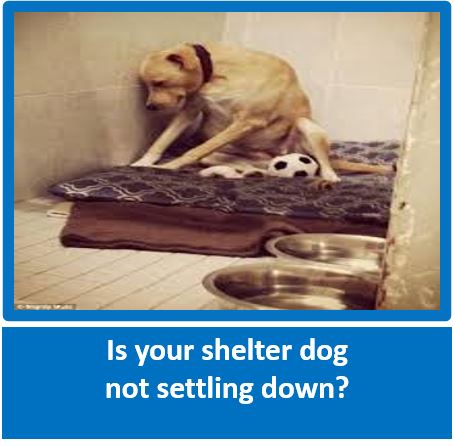.

Dogs dig to bury bones, and later to dig them up again. Dogs dig cooling hollows in the summer, and warming pits in the winter. Dogs dig after eavesdropping on private ultrasonic conversation of subterranean critters. Bitches dig dens when they are pregnant. Dogs dig out of boredom, and dogs dig to escape. But by and large, most dogs dig for the sheer fun of it.
Dogs Don’t See Your Problem
Dogs consider digging to be a perfectly normal and natural doggy activity. In fact, terriers consider digging to be their very reason for being. It would therefore be fruitless to try to stop your dog from digging altogether. Prevention and treatment of misplaced digging focus on management and education: preventing your dog from digging in inappropriate areas and redirecting your dog’s natural digging-desire to a suitable area.
Prevent Digging in Your Absence
When you are indoors, keep your dog indoors. When you are at home, try your best to accompany your dog outdoors to supervise and teach garden rules.
Housesoiling, destructive chewing, and hyperactivity are the most common reasons why dogs are relegated to unsupervised, solitary confinement in the yard, where they predictably learn to bark, dig, and escape, and become over-excited whenever let indoors. Consequently, it is important to housetrain and chewtoy-train your dog. (See Housetraining and Destructive Chewing blueprints). Teach you dog to settle down calmly and quietly indoors, and to sit when greeting visitors (see Hyperdog! Blueprint). Then your dog may remain safely indoors whether you are home or not. Your air-conditioned and centrally-heated house is the safest and most comfortable place for your dog to spend the day. When you are at home, go outside and enjoy your garden with your dog.
Some dogs dig to escape because they cannot bear the boredom and anxiety of solitary confinement in the yard. Escaping its exceedingly dangerous for your dog’s health. So if you decide to leave your dog in the yard, make the yard more interesting and be sure to fix the fence. Also make sure your dog has a cool resting place in the summer and warmth in the winter. Teach your dog to dissipate digging energy with other activities. Make sure your dog is well exercises (psychologically as well as physically) and entertained, and thus has no need to dig to escape from the yard. Teach recreational diggers to become recreational chewers. If your dog is busying himself with a chewtoy, he has little time to dig. Consequently, chewtoys stuffed with breakfast kibble are the best objects to leave indoors, or to bury in your dog’s digging pit. You must teach your dog how to entertain himself outdoors. This means your dog needs chewtoys outside too.
Redirect Digging to a Digging Pit
Since you consider your dog’s choice of digging locations to be inappropriate, choose a location to your liking and teach your dog to dig there. Build your dog a digging pit (much like a child’s sandbox) in a suitable corner of the yard.
Bury a cow‘s femur (the whole thing) in your dogs digging pit. Your little doggie will be utterly delighted when she finds a huge meaty bone. Now, this single simply procedure may not totally prevent holes in other areas of the garden, but your dog will now be much more inclined to dig in her digging pit. I mean, in 1849 everyone started rushing westwards to California. They didn’t rush to New Jersey. And why did they rush to California? Because one person discovered a nugget of gold at Sutter’s Mill. They didn’t find gold in New Jersey, and so they didn’t rush to New Jersey. And so it is with dogs. After just one remarkable find, your dog will prefer to excavate in that California corner – her digging pit, where she once found something very worth finding.
Every morning, fill several chewtoys with your dog’s breakfast kibble and bury them in her digging pit. Your dog will discover that the digging pit is a virtual treasure trove where she can find toys for sustenance and entertainment.
Garden Rules
Once the dog’s digging activities have been redirected to a suitable location in your yard, you might consider protecting other parts of the garden. Lay down chicken wire or chain-link fencing over the lawn and flower beds, add plenty of topsoil and reseed.
Use boundary fences to partition the yard into doggy and non-doggy zones. The fences are not meant to be dog proof: rather, they are used as training aids to clearly demarcate lawn and garden boundaries to help you teach the rules. Always try to accompany your dog when he goes outside, especially during puppyhood or the first few months an older dog is at home. Remember, an owner in the yard is worth two in front of the television! It is not fair to keep garden rules a secret from your dog and then get angry with the dog for breaking rules he didn’t even know existed. Encourage and praise your dog for walking on paths and for lying down in dog zones. Tie a number of stuffed chewtoys to ground stakes or hang them for tree branches in dog zones to encourage your dog to want to spend time in those areas. Discourage your dog from entering non-doggy zones.
If you require a more detailed description, read out Digging booklet. To teach you dog to use a digging pit, you will need numerous stuffable chewtoys and some freeze-dried liver treats. These products are available from your local pet store or on-line from www.amazon.com
Dogs Don’t See Your Problem
Dogs consider digging to be a perfectly normal and natural doggy activity. In fact, terriers consider digging to be their very reason for being. It would therefore be fruitless to try to stop your dog from digging altogether. Prevention and treatment of misplaced digging focus on management and education: preventing your dog from digging in inappropriate areas and redirecting your dog’s natural digging-desire to a suitable area.
Prevent Digging in Your Absence
When you are indoors, keep your dog indoors. When you are at home, try your best to accompany your dog outdoors to supervise and teach garden rules.
Housesoiling, destructive chewing, and hyperactivity are the most common reasons why dogs are relegated to unsupervised, solitary confinement in the yard, where they predictably learn to bark, dig, and escape, and become over-excited whenever let indoors. Consequently, it is important to housetrain and chewtoy-train your dog. (See Housetraining and Destructive Chewing blueprints). Teach you dog to settle down calmly and quietly indoors, and to sit when greeting visitors (see Hyperdog! Blueprint). Then your dog may remain safely indoors whether you are home or not. Your air-conditioned and centrally-heated house is the safest and most comfortable place for your dog to spend the day. When you are at home, go outside and enjoy your garden with your dog.
Some dogs dig to escape because they cannot bear the boredom and anxiety of solitary confinement in the yard. Escaping its exceedingly dangerous for your dog’s health. So if you decide to leave your dog in the yard, make the yard more interesting and be sure to fix the fence. Also make sure your dog has a cool resting place in the summer and warmth in the winter. Teach your dog to dissipate digging energy with other activities. Make sure your dog is well exercises (psychologically as well as physically) and entertained, and thus has no need to dig to escape from the yard. Teach recreational diggers to become recreational chewers. If your dog is busying himself with a chewtoy, he has little time to dig. Consequently, chewtoys stuffed with breakfast kibble are the best objects to leave indoors, or to bury in your dog’s digging pit. You must teach your dog how to entertain himself outdoors. This means your dog needs chewtoys outside too.
Redirect Digging to a Digging Pit
Since you consider your dog’s choice of digging locations to be inappropriate, choose a location to your liking and teach your dog to dig there. Build your dog a digging pit (much like a child’s sandbox) in a suitable corner of the yard.
Bury a cow‘s femur (the whole thing) in your dogs digging pit. Your little doggie will be utterly delighted when she finds a huge meaty bone. Now, this single simply procedure may not totally prevent holes in other areas of the garden, but your dog will now be much more inclined to dig in her digging pit. I mean, in 1849 everyone started rushing westwards to California. They didn’t rush to New Jersey. And why did they rush to California? Because one person discovered a nugget of gold at Sutter’s Mill. They didn’t find gold in New Jersey, and so they didn’t rush to New Jersey. And so it is with dogs. After just one remarkable find, your dog will prefer to excavate in that California corner – her digging pit, where she once found something very worth finding.
Every morning, fill several chewtoys with your dog’s breakfast kibble and bury them in her digging pit. Your dog will discover that the digging pit is a virtual treasure trove where she can find toys for sustenance and entertainment.
Garden Rules
Once the dog’s digging activities have been redirected to a suitable location in your yard, you might consider protecting other parts of the garden. Lay down chicken wire or chain-link fencing over the lawn and flower beds, add plenty of topsoil and reseed.
Use boundary fences to partition the yard into doggy and non-doggy zones. The fences are not meant to be dog proof: rather, they are used as training aids to clearly demarcate lawn and garden boundaries to help you teach the rules. Always try to accompany your dog when he goes outside, especially during puppyhood or the first few months an older dog is at home. Remember, an owner in the yard is worth two in front of the television! It is not fair to keep garden rules a secret from your dog and then get angry with the dog for breaking rules he didn’t even know existed. Encourage and praise your dog for walking on paths and for lying down in dog zones. Tie a number of stuffed chewtoys to ground stakes or hang them for tree branches in dog zones to encourage your dog to want to spend time in those areas. Discourage your dog from entering non-doggy zones.
If you require a more detailed description, read out Digging booklet. To teach you dog to use a digging pit, you will need numerous stuffable chewtoys and some freeze-dried liver treats. These products are available from your local pet store or on-line from www.amazon.com




